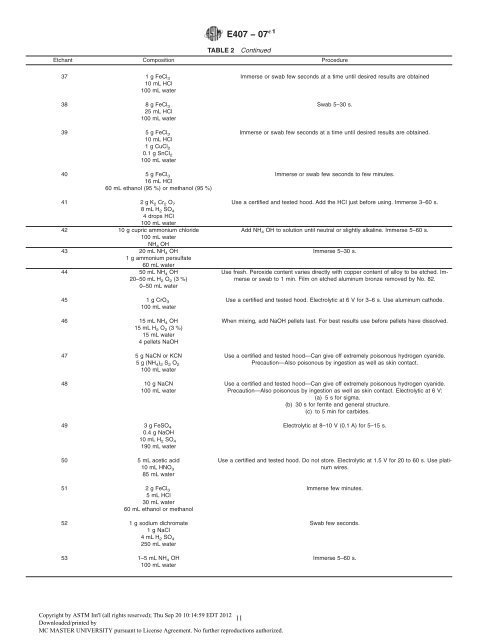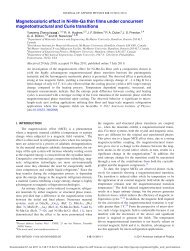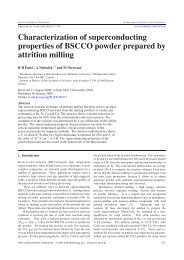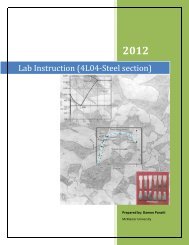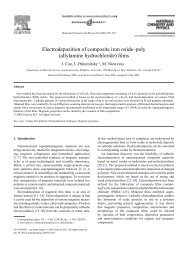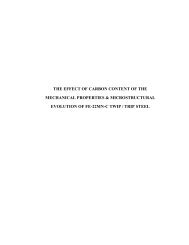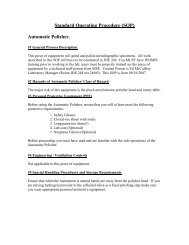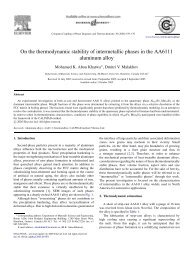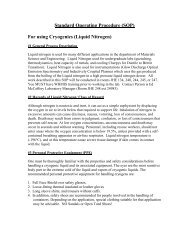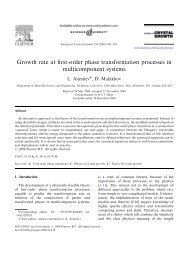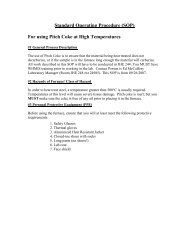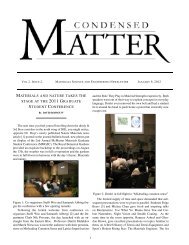E407-07 Microetching Metals and Alloys.pdf - McMaster Department ...
E407-07 Microetching Metals and Alloys.pdf - McMaster Department ...
E407-07 Microetching Metals and Alloys.pdf - McMaster Department ...
You also want an ePaper? Increase the reach of your titles
YUMPU automatically turns print PDFs into web optimized ePapers that Google loves.
TABLE 2 Continued<br />
Etchant Composition Procedure<br />
37 1 g FeCl 3<br />
10 mL HCl<br />
100 mL water<br />
38 8 g FeCl 3<br />
25 mL HCl<br />
100 mL water<br />
39 5 g FeCl 3<br />
10 mL HCl<br />
1 g CuCl 2<br />
0.1 g SnCl 2<br />
100 mL water<br />
40 5 g FeCl3 16 mL HCl<br />
60 mL ethanol (95 %) or methanol (95 %)<br />
Immerse or swab few seconds at a time until desired results are obtained<br />
Swab 5–30 s.<br />
Immerse or swab few seconds at a time until desired results are obtained.<br />
Immerse or swab few seconds to few minutes.<br />
41 2gK2 Cr2 O7 8mLH2SO4 4 drops HCl<br />
100 mL water<br />
Use a certified <strong>and</strong> tested hood. Add the HCl just before using. Immerse 3–60 s.<br />
42 10 g cupric ammonium chloride<br />
100 mL water<br />
NH4 OH<br />
Add NH4 OH to solution until neutral or slightly alkaline. Immerse 5–60 s.<br />
43 20 mL NH4 OH<br />
1 g ammonium persulfate<br />
60 mL water<br />
Immerse 5–30 s.<br />
44 50 mL NH 4 OH<br />
20–50 mL H 2 O 2 (3 %)<br />
0–50 mL water<br />
45 1gCrO 3<br />
100 mL water<br />
46 15 mL NH 4 OH<br />
15 mL H 2 O 2 (3 %)<br />
15 mL water<br />
4 pellets NaOH<br />
47 5 g NaCN or KCN<br />
5g(NH 4) 2 S 2 O 2<br />
100 mL water<br />
48 10 g NaCN<br />
100 mL water<br />
49 3 g FeSO 4<br />
0.4 g NaOH<br />
10 mL H 2 SO 4<br />
190 mL water<br />
50 5 mL acetic acid<br />
10 mL HNO 3<br />
85 mL water<br />
51 2 g FeCl 3<br />
5 mL HCl<br />
30 mL water<br />
60 mL ethanol or methanol<br />
52 1 g sodium dichromate<br />
1 g NaCl<br />
4mLH 2 SO 4<br />
250 mL water<br />
53 1–5 mL NH 4 OH<br />
100 mL water<br />
<strong>E4<strong>07</strong></strong> − <strong>07</strong> ´1<br />
Copyright by ASTM Int'l (all rights reserved); Thu Sep 20 10:14:59 EDT 2012<br />
11<br />
Downloaded/printed by<br />
MC MASTER UNIVERSITY pursuant to License Agreement. No further reproductions authorized.<br />
Use fresh. Peroxide content varies directly with copper content of alloy to be etched. Immerse<br />
or swab to 1 min. Film on etched aluminum bronze removed by No. 82.<br />
Use a certified <strong>and</strong> tested hood. Electrolytic at 6 V for 3–6 s. Use aluminum cathode.<br />
When mixing, add NaOH pellets last. For best results use before pellets have dissolved.<br />
Use a certified <strong>and</strong> tested hood—Can give off extremely poisonous hydrogen cyanide.<br />
Precaution—Also poisonous by ingestion as well as skin contact.<br />
Use a certified <strong>and</strong> tested hood—Can give off extremely poisonous hydrogen cyanide.<br />
Precaution—Also poisonous by ingestion as well as skin contact. Electrolytic at 6 V:<br />
(a) 5 s for sigma.<br />
(b) 30 s for ferrite <strong>and</strong> general structure.<br />
(c) to 5 min for carbides.<br />
Electrolytic at 8–10 V (0.1 A) for 5–15 s.<br />
Use a certified <strong>and</strong> tested hood. Do not store. Electrolytic at 1.5 V for 20 to 60 s. Use platinum<br />
wires.<br />
Immerse few minutes.<br />
Swab few seconds.<br />
Immerse 5–60 s.


